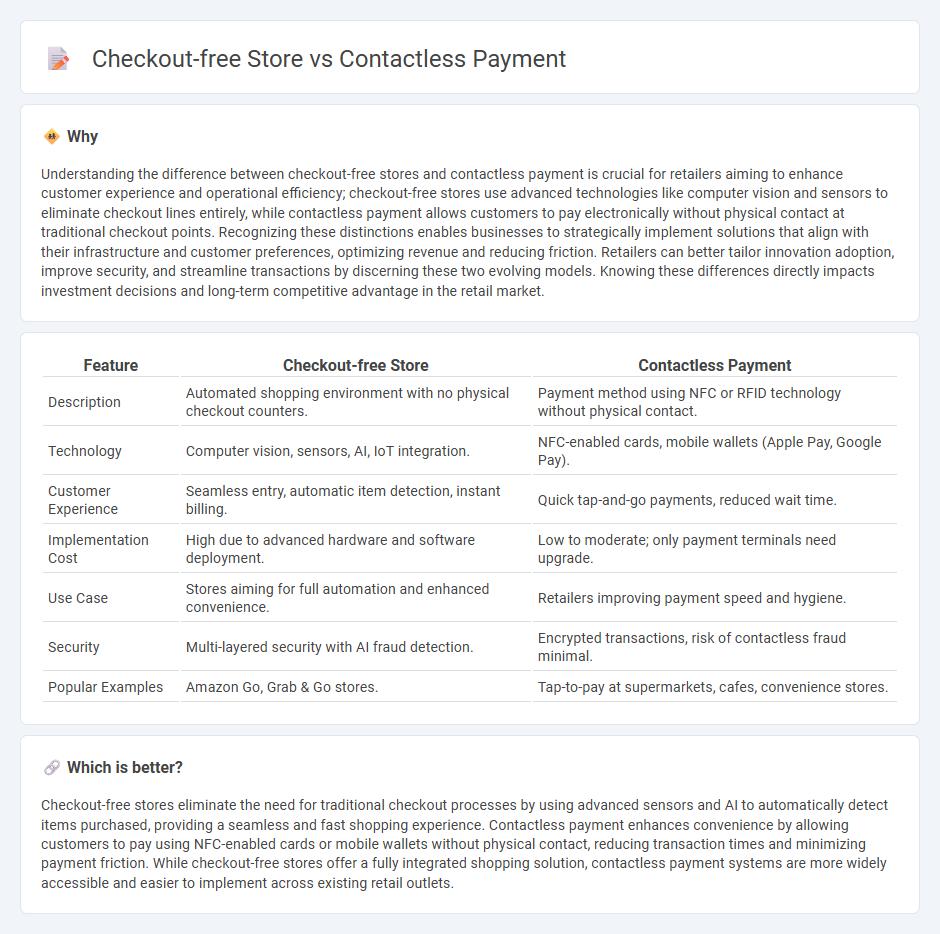
Checkout-free stores eliminate traditional cashier interactions by using sensors and AI to automatically charge customers as they exit, streamlining the shopping experience with speed and convenience. Contactless payment technology, including NFC-enabled cards and mobile wallets, enables fast, secure transactions without physical contact, complementing modern retail environments. Explore the latest innovations transforming retail efficiency and customer satisfaction.
Why it is important
Understanding the difference between checkout-free stores and contactless payment is crucial for retailers aiming to enhance customer experience and operational efficiency; checkout-free stores use advanced technologies like computer vision and sensors to eliminate checkout lines entirely, while contactless payment allows customers to pay electronically without physical contact at traditional checkout points. Recognizing these distinctions enables businesses to strategically implement solutions that align with their infrastructure and customer preferences, optimizing revenue and reducing friction. Retailers can better tailor innovation adoption, improve security, and streamline transactions by discerning these two evolving models. Knowing these differences directly impacts investment decisions and long-term competitive advantage in the retail market.
Comparison Table
| Feature | Checkout-free Store | Contactless Payment |
|---|---|---|
| Description | Automated shopping environment with no physical checkout counters. | Payment method using NFC or RFID technology without physical contact. |
| Technology | Computer vision, sensors, AI, IoT integration. | NFC-enabled cards, mobile wallets (Apple Pay, Google Pay). |
| Customer Experience | Seamless entry, automatic item detection, instant billing. | Quick tap-and-go payments, reduced wait time. |
| Implementation Cost | High due to advanced hardware and software deployment. | Low to moderate; only payment terminals need upgrade. |
| Use Case | Stores aiming for full automation and enhanced convenience. | Retailers improving payment speed and hygiene. |
| Security | Multi-layered security with AI fraud detection. | Encrypted transactions, risk of contactless fraud minimal. |
| Popular Examples | Amazon Go, Grab & Go stores. | Tap-to-pay at supermarkets, cafes, convenience stores. |
Which is better?
Checkout-free stores eliminate the need for traditional checkout processes by using advanced sensors and AI to automatically detect items purchased, providing a seamless and fast shopping experience. Contactless payment enhances convenience by allowing customers to pay using NFC-enabled cards or mobile wallets without physical contact, reducing transaction times and minimizing payment friction. While checkout-free stores offer a fully integrated shopping solution, contactless payment systems are more widely accessible and easier to implement across existing retail outlets.
Connection
Checkout-free stores rely extensively on contactless payment technologies to streamline the shopping experience. These stores use sensors, cameras, and AI to automatically track items, enabling customers to pay seamlessly through mobile wallets or NFC-enabled cards without traditional checkout lines. The integration of contactless payment systems enhances efficiency and reduces transaction times, driving the adoption of checkout-free retail environments.
Key Terms
NFC (Near Field Communication)
NFC (Near Field Communication) technology enables contactless payments by allowing devices to communicate over short distances, providing a fast and secure transaction method at checkout counters. Checkout-free stores leverage NFC alongside sensors and AI to create seamless shopping experiences where customers automatically pay as they exit, eliminating traditional checkout lines. Explore how NFC advancements are revolutionizing retail environments and payment systems.
Computer Vision
Computer vision technology plays a crucial role in checkout-free stores by enabling real-time item recognition, customer tracking, and seamless payment processing without traditional scanning. Contactless payment primarily relies on NFC or RFID for quick transactions but does not inherently support automatic item identification or inventory management. Explore how advanced computer vision integrates with retail to revolutionize payment and shopping experiences.
RFID (Radio Frequency Identification)
RFID technology enables contactless payment by allowing quick data transmission between a payment card or device and a reader without physical interaction, speeding up transactions. Checkout-free stores leverage RFID to track items automatically as customers pick them up, eliminating the need for traditional cashier checkouts and enhancing shopping efficiency. Explore how RFID transforms retail experiences and payment methods for a seamless future.
Source and External Links
What Is Contactless Payment and How Does it Work (2025) - Contactless payment is a secure method using NFC technology that allows users to tap a card, phone, or wearable on a terminal for fast, encrypted transactions without physical contact or PIN entry for small purchases.
What Is a Contactless Card & How Does It Work? - Contactless credit and debit cards enable payments by tapping on a compatible terminal, offering a faster and more secure alternative to swiping or inserting cards, often indicated by a four-curved-line symbol.
Contactless payment - Contactless payment systems use RFID or NFC in credit/debit cards, key fobs, or mobile devices to securely pay by proximity to a reader; widely adopted standards include EMV, and popular services include Apple Pay and Google Pay employing tokenization for security.
 dowidth.com
dowidth.com